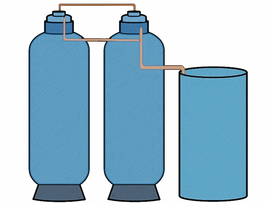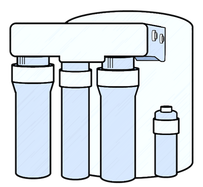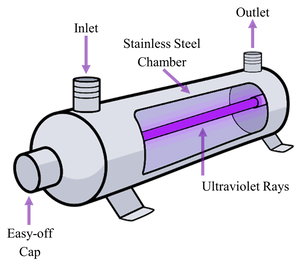|
There are many devices available for treating drinking water in the home, ranging from small pitchers to complex home systems. Factors to consider include contaminants of concern, space and installation limitations, cost, and the home's water supply (i.e., municipal or private well). While no single technology can remove all waterborne contaminants, a combination of processes can be used to reduce a wide array of contaminants. Continue reading below to learn more about common treatment technologies. |
Click here to search for water treatment devices that have been certified to NSF/ANSI standards. Certification ensures that the device is made from safe materials and the contaminant reduction claims listed on the packaging are verified by independent lab testing. |
Types of Treatment: The categories below broadly represent various types of water treatment. Many of these filtration types can be used separately or together as part of a multi-barrier system. Sediment (SED), Granular Activated Carbon (GAC), and Activated Carbon Block (ACB) are useful for removing large particles and may be used as prefiltration in a larger system. Membrane filtration, such as Reverse Osmosis (RO), separates contaminants and dissolved solids. Disinfection technologies, such as Ultraviolet (UV) Light and Ozone, may be used independently or as another step in a layered approach.
|
Filtration Removes large particles, improves taste & odor E.g., SED, GAC, ACB |
Membrane Filtration Separates contaminants and dissolved solids, E.g., Reverse Osmosis |
Disinfection Removes most microbial contaminants, E.g., UV & Ozone |
Post-Filtration Activated Carbon Removes small particles & improves taste & odor |
|
Water Softeners (Ion Exchange)
Water softeners are a point-of-entry (POE) type of treatment. This means the water is filtered as it enters the home, providing treated water at all faucets, shower heads, and water-using appliances. Household water softeners use ion exchange to replace hardness-causing ions (E.g., calcium, magnesium) with non-hardness ions (E.g., sodium chloride). Some can be designed to remove positive and/or negative charged contaminants, such as: iron and manganese, heavy metals, some radioactive compounds, nitrates, arsenic, chromium, selenium, and sulfate. However, water softeners do not protect against biological contaminants. |
|
Benefits:
|
Limitations
|
|
Activated Carbon
Activated Carbon is perhaps the most universally used technology, primarily used to remove organic chemicals. The filters act as an adsorbent to remove or reduce levels of water contaminants that affect the taste and odor of water, as well as harmful solvents, pesticides, and hazardous chemical wastes. They can also reduce radioactive compounds, chlorine, disinfection by-products (DPBs), and lead. It does not, however, remove harmful microbes. |
|
Benefits:
|
Limitations
|
|
Reverse Osmosis
Reverse osmosis (RO) is a process where water and contaminants are separated by passage through a thin semipermeable membrane. The membrane creates a barrier between water molecules and chemical or microbial contaminants as high-pressure forces water through the membrane, leaving contaminants behind. RO systems can remove most organics, metals and nitrate but are often used in succession with activated carbon and UV light for increased efficiency and for removal of inorganic compounds. This multibarrier approach eliminates a wide variety of contaminants that no single system can fully address. |
|
Benefits:
|
Limitations
|
|
Ultraviolet (UV)
UV light utilizes radiation disrupting cellular DNA to kill microbes but is not utilized for removal of chemical contaminants. This treatment tool is generally used as a final step in RO systems to improve the efficiency of microbe removal originating from the source water or that may grow in the POU system over time. All units require some level of routine maintenance, which may include cleaning and sanitizing and filter or light changes. In addition, some units require professional installation with associated labor fees. |
|
Benefits:
|
Limitations
|
Ozone
Ozone is a highly reactive molecule composed of 3 oxygen atoms. When produced under controlled conditions, the oxidizing power of ozone can be harnessed and utilized to destroy harmful microbes contaminating food, water, and even surfaces.
Ozone is a highly reactive molecule composed of 3 oxygen atoms. When produced under controlled conditions, the oxidizing power of ozone can be harnessed and utilized to destroy harmful microbes contaminating food, water, and even surfaces.
|
Benefits:
|
Limitations
|







